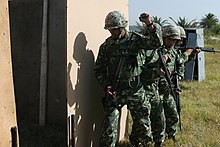Close Quarters Battle
The English terms Close Quarters Combat (CQC) or Close Quarters Battle (CQB) can be translated as close quarters combat by all means. In the military field CQC, CQB is often incorrectly with the urban warfare equal or fighting in buildings and urban environments.
Strictly speaking, the CQC is a man-to-man fight, while CQB means more than one man against an opponent at close range. Following the experience of the Iraq war that the average combat distances are only 29 meters, the CQC / CQB training is becoming increasingly important for military forces of all types of service. The principles of the CQC / CQB are also practiced in police units.
In the Israeli armed forces, CQC is summarized under the term Krav Panim el Panim ( KAPAP , face to face fight). The melee skills taught include all distances and weapons.
Combat distances
CQC and CQB includes armed and unarmed hand-to-hand combat . A distinction is made between the following combat distances:
- Firearms distance far (approx.> 30 meters) However, it is not possible to give an exact specification in meters, as the terrain and coverage options play an essential role.
- Firearm distance close (approx. <30 meters)
- Kick distance
- Baton removal
- Knife removal
- Fist / hand removal
- Elbow / knee removal
- Ground combat - wrestling

